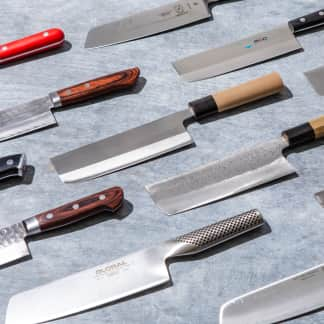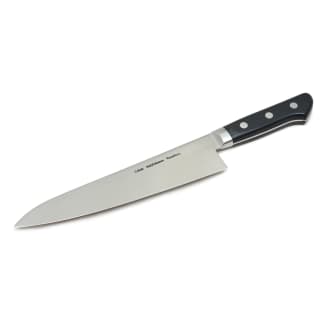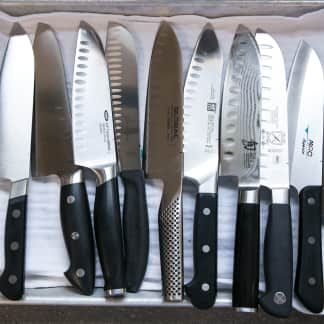Our favorite inexpensive chef’s knife is the Victorinox Fibrox Pro 8-inch Chef's Knife. We’ve routinely tested and recommended this knife for nearly three decades, and for good reason: It cuts foods of all kinds effortlessly, is comfortable for hands of all sizes to grip, and arrives and stays quite sharp. It’s also reliably durable, easy to sharpen, and well-made. We think it’s the best choice for most people. We also love the Mercer Culinary Renaissance 8-Inch Forged Chef's Knife. It’s just as sharp and adept in the kitchen as our top choice and is a great option for cooks who prefer heavier knives and don’t mind a slightly slicker handle. If you are on a particularly tight budget, we think that the Mercer Culinary Millennia 8-Inch Chef's Knife offers great value. It costs half as much as our top choices and performs just as well. Our only quibble is that its handle is made from a highly textured rubber that some users found less pleasant to hold.

A good chef’s knife is a cook’s best friend. It’s arguably the most important tool in the kitchen, an essential all-purpose blade that can do everything from small, precise tasks (mincing garlic) to minor butchery (breaking down a chicken, filleting a fish) and a whole lot in between. Many say that if you buy just one knife, let it be a chef’s knife.



We use our chef's knives for pretty much everything—slicing sandwiches, prepping vegetables, and even breaking down roasts.
We’ve recommended our favorite chef’s knife for almost three decades, retesting it repeatedly since new knives enter the market all the time. To see if our favorite held up to the competition, we tested it against a fresh crop of options. Since our favorite doesn’t cost much—usually less than $40—we set the price cap for our lineup at $75. We focused on knives with blades measuring about 8 inches, as we’ve found this length to be the most useful and versatile for most cooks. And we limited our lineup to knives with stainless-steel or stain-resistant steel blades because they are the easiest to care for (see our testing of carbon-steel knives).
What to Look For
- A Sharp Blade: A sharp knife is a pleasure to use, making quick work of any task. We think a chef’s knife should be keen and ready to use right out of the box, since not all cooks have the equipment or skills to sharpen their knives at home. Two main factors determine sharpness. One is edge angle—the angle of the blade on either side of its cutting edge. The narrower the angle, the thinner the cutting edge and the sharper the knife can feel in action. Most of the knives we tested had narrow edge angles of 13 to 16 degrees, which would—in theory—be enough of an angle to make a knife feel sharp. In practice, the sharpness of many of the blades came down to a second factor: how well they had been sharpened and honed at the factory. The best knives had smooth, even-looking edges with no chips. Our top two knives had edge angles on the upper half of the range but had been nicely sharpened so that they glided through onions and tomatoes as smoothly as knives with narrower edge angles.
- A Gently Curved Blade: Chef’s knives have blades that are curved to enable cuts where you rock the blade forward from tip to heel. We preferred blades where the curve was fairly gentle, allowing a natural cutting motion. Blades with more exaggerated, rounded bellies occasionally put our arms and wrists at slightly more awkward angles as we cut.

We preferred knives with gently curved blades (top), as these allowed us to make different types of cuts easily. Knives with more dramatically curved blades (bottom) sometimes put our arms and wrists at awkward angles as we cut.
- Clearance Under the Handle: In general, the taller the blade was at the heel, the higher the handle sat above the cutting board, providing more space underneath it for our fingers to curl. Our favorite blades were about 2 inches tall at the heel. Blades that were shorter sometimes didn’t leave enough room for our fingers, pushing them into the cutting board as we rocked through cuts.

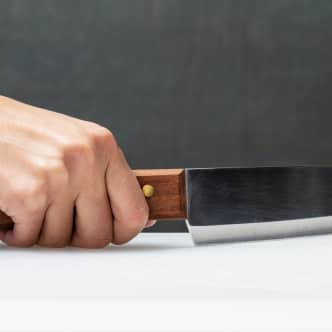
Blades that were tall at the heel (left) left plenty of room for our fingers to curl around the handle; blades that were narrow (right) didn't provide enough clearance, cramping our fingers.
- A Rounded, Tapered Spine: We liked blades with rounded spines, as they were more comfortable to choke up on than those with sharper, squared-off spines, which dug into our hands. And we liked spines that were relatively thick toward the handle end. They helped keep the blades rigid so that they were easy to direct when cutting, and they conferred extra power when we used the heel of the knife to chop through dense butternut squash or chicken bones. The best spines also tapered quickly from the handle end, so the tip was thin enough to make precise cuts, such as when dicing an onion or mincing garlic.
- A Grippy Handle with Rounded Edges: We preferred knives with handles made from rubbery, textured materials, as these were cushier and easier to grip, especially when our hands were wet or greasy. We didn’t have clear preferences on the shape of the handle. We liked uniformly cylindrical Japanese-style handles and curvier handles with ergonomic bumps; both gave us plenty of grip options. Regardless of style, the best handles had soft, rounded contours, nestling into our hands instead of biting into them.

The best knives were able to chop tough butternut squash with authority; lesser knives faltered, wobbled, or got stuck.
What to Avoid
- A Dull or Poorly Sharpened Blade: A dull blade will mangle your food, bruising your parsley and crushing your onion into eye-watering pulp instead of dicing it neatly. It’s also dangerous; it’ll slip on chicken skin or require extra force to push through a potato, putting your fingers at risk. To our chagrin, several of the knives we tested came out of the box with dull, coarse, toothy, or inconsistently sharpened edges (e.g., sharp at the tip yet dull at the heel).
- A Thick Spine: Blades with uniformly thick spines got stuck in butternut squash, wedging into it like an axe into a piece of wood. They also struggled more with tasks performed at the tip, feeling clumsy and imprecise when we used them to mince garlic or dice onions.

We preferred blades with relatively thin spines (top), as they maneuvered more nimbly through foods and were less likely than thick-spined blades (bottom) to get stuck in tough or dense foods.
- An Ultrathin Blade: Thin blades are great for relatively light use and precision tasks, such as mincing garlic or dicing onions, but they're not necessarily ideal in an all-purpose knife. Measuring just 1.3 millimeters thick, the thinnest blade struggled on tasks that required more power, wobbling and bending alarmingly when we bore down on it while cutting through chicken breasts.
Other Considerations
- Weight: Some testers liked heavier knives, saying they felt especially solid and well-made in their hands. Others preferred fairly lightweight knives, finding them easier to use for long periods without tiring. Ultimately, the choice is personal; our top choices include a lighter option and a heavier option.
The Tests:
- Evaluate each knife’s sharpness using an industrial sharpness-testing machine at the beginning and end of testing
- Slice tomatoes
- Dice onions
- Mince garlic
- Mince parsley
- Break down a whole chicken into parts
- Break down butternut squash and dice it
How We Rated:
- Blade: We evaluated how spine shape, blade height and curvature, and other factors contributed to each knife’s performance.
- Handle: We rated each knife on how comfortable its handle was to grip.
- Sharpness: We rated the knives on how sharp they were before, during, and at the end of testing.




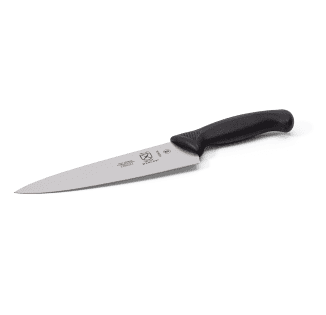



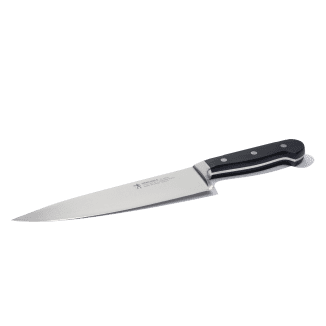








 Buy at Opinel
Buy at Opinel




